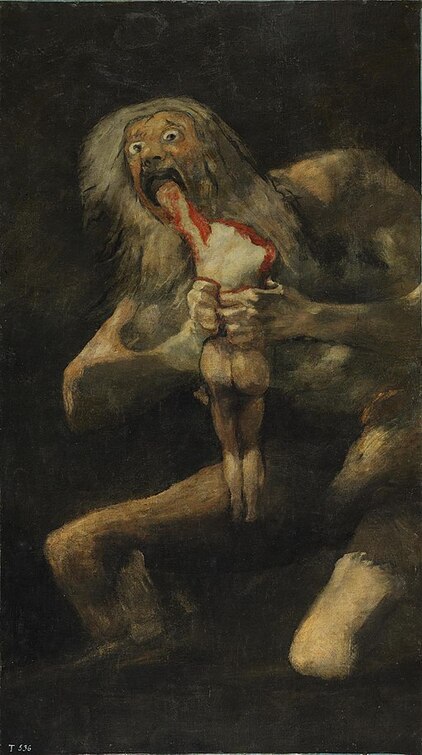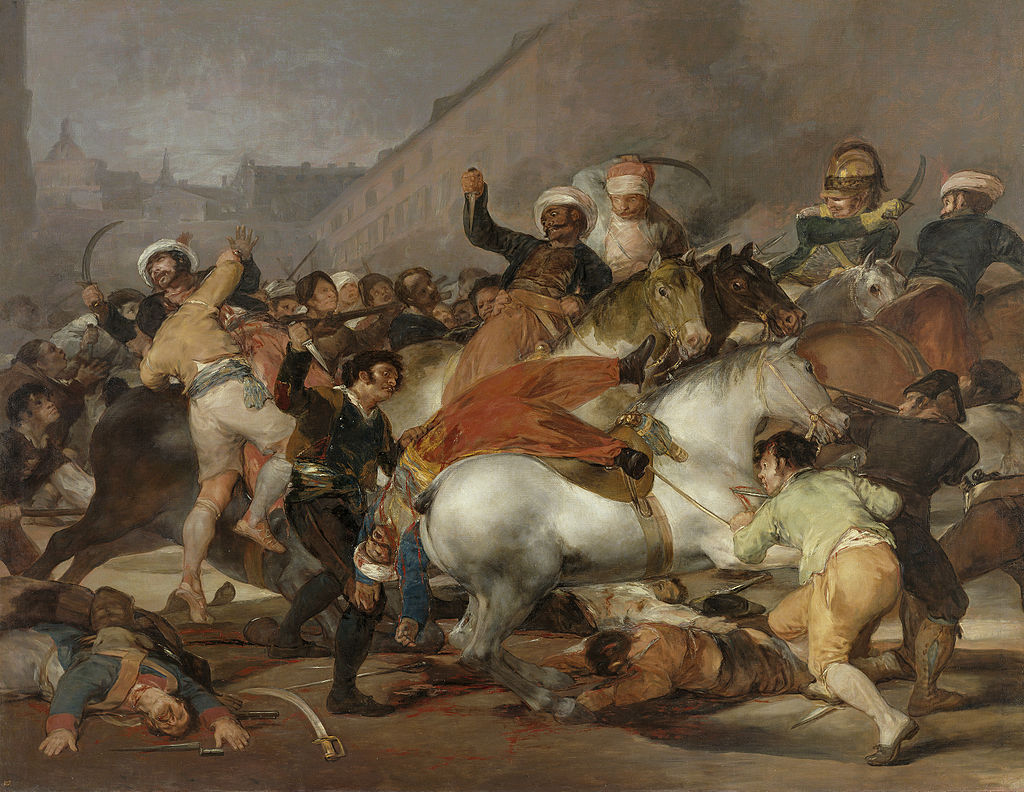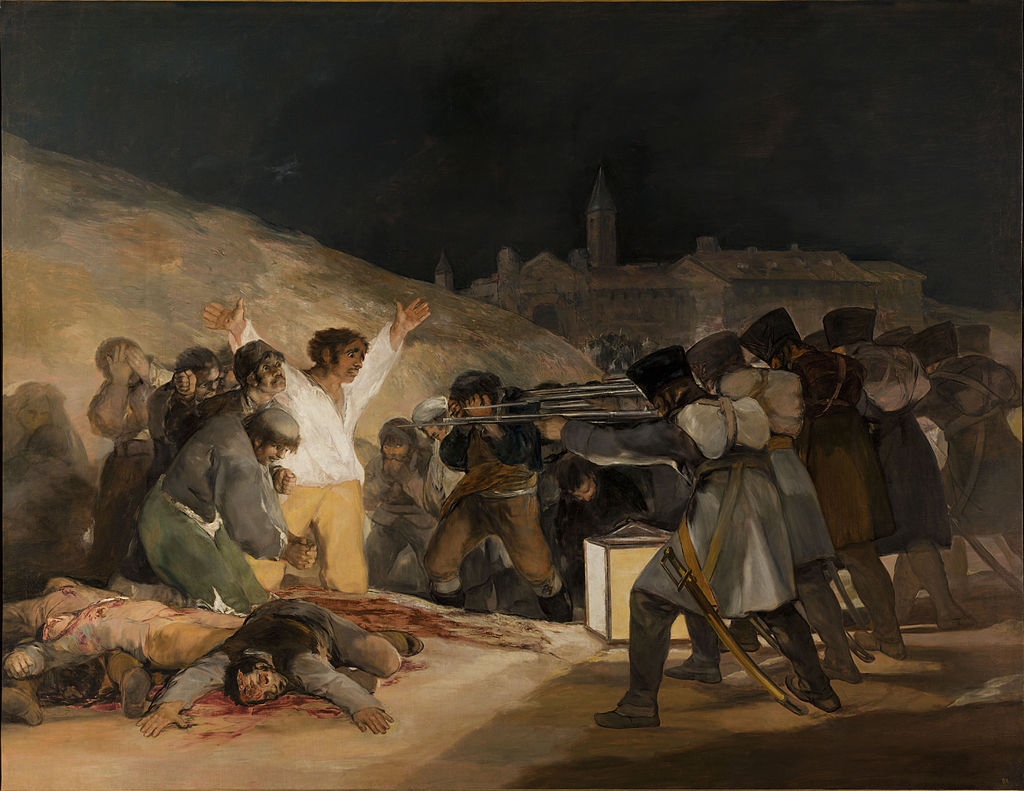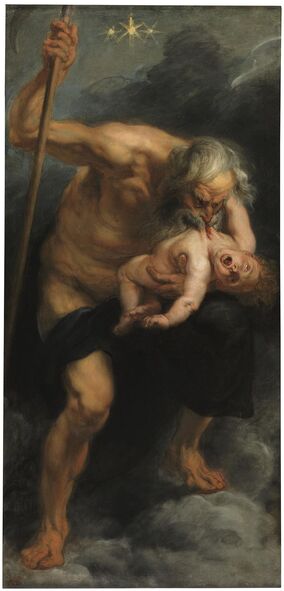|
Where? Room 67 on Floor 0 of the Prado Museum
When? 1820-1823 What do you see? The power-hungry god of time, Saturn, stands in the darkness with the corpse of his son in his hands. His grotesque limbs are abnormally long and twisted. The yellow color of his skin gives him a sickly and monstrous appearance. With a mouth as wide as his eyes, he bites pieces of flesh out of his son’s body. The head and right arm have already been devoured. The corpse hangs limp in his firm hands, fingers digging into the back. Surrounded by muted colors and a black background, the blood flowing out of the son’s body is particularly striking. Slowly, the background seems to obscure Saturn’s body as the shadows slowly swallow his right elbow and thighs. Backstory: In his villa outside of Madrid, Goya created a series of disturbing images which have since been dubbed his Pinturas Negras or Black Paintings. Painted towards the end of his life, these paintings reflected Goya’s pessimistic view towards humanity. The works deal with dark and disturbing themes. One of the most iconic works of this dark series was Saturn Devouring His Son. The painting was created in his dining room, perhaps in response to the Napoleonic Wars which took place towards the end of his life. Witnessing the Spanish government at its worst, Goya was heavily concerned with topics such as abuse of power and violence. Another example of Goya’s black paintings is Witches’ Sabbath which is also on display in the Prado Museum.
The Myth of Saturn: In Greek and Roman mythology, Saturn was the son of Caelus, the god of the sky. When he realized that Caelus’s rule was tyrannical, Saturn overthrew his father and took his place as a supreme leader. Saturn and his wife, Ops, were soon expecting six children. However, it was prophesied that one of these children would overthrow him, granting him a fate not unlike that of Caelus.
In an effort to escape this fate, Saturn devoured five of his children as soon as they were born. Horrified, Ops hid the sixth child, Jupiter, from Saturn and replaced him with a stone wrapped in cloth. Saturn ate the stone and as it passed through his system, it freed the five children that he had swallowed. Later, Jupiter would indeed overthrow his father as a supreme leader and Saturn fled to Latium where he became a god of agriculture. Who is Francisco Goya? Francisco José de Goya y Lucientes was born in 1746 in Fuendetodos in the Northeast of Spain and died in 1828 in Bordeaux, France. He studied drawing and painting in Zaragoza and joined the studio of José Luzán. Later, he studied under Francisco Bayeu Subías who led him to work on decorations for the royal palace. Goya married Subías’s sister and traveled to Italy after failing in two drawing competitions at the Real Academia des Bellas Artes in San Fernando. Eventually, Goya was appointed painter to the Royal Tapestry Factory in Madrid. His work was reminiscent of Rococo art and focused on day-to-day events. As his work gained more attention, Goya rose to the position of court painter to King Charles III and King Charles IV. Around this time, he began to travel Andalusia to study realism. He was commissioned by the Spanish Court to paint some anti-war pieces such as The Second of May 1808 and The Third of May 1808. Goya lived in a villa outside of Madrid called Quinta del Sordo which used to belong to a deaf man. In the later stages of his life, Goya fell ill to an unknown sickness and suffered a hearing loss of his own. Along with his physical health, Goya’s mental health went into decline. Living through major turmoil in Spain, Goya’s outlook on life became very pessimistic and his work became dark and deeply disturbing. The walls of his villa were covered in murals of “Black Paintings’ which have since been transferred onto canvas and moved into the Prado Museum.
Fun fact: Saturn Devouring His Son is believed to have been inspired by Peter Paul Rubens’ Saturn which was painted in the 1630s. Rubens’ depiction of Saturn appears to have more consciousness and awareness of his decision of eating his son. Goya, on the other hand, depicts Saturn as completely lost in chaos and fear, consuming his child as if it were necessary for his survival.
Written by Sabrina Tian
References:
0 Comments
Leave a Reply. |
Categories
All
|
- Home
- Blog
-
Museums
- Alte Pinakothek
- Art Institute of Chicago
- Baltimore Museum of Art
- Barber Institute of Fine Arts
- Bargello
- Barnes Foundation
- British Museum
- Church of Sant’Anastasia
- Cleveland Museum of Art
- Courtauld Institute of Art
- Detroit Institute of Arts
- Frans Hals Museum
- Galleria Borghese
- Gallerie dell'Accademia
- Getty Museum
- Guggenheim
- Hermitage Museum
- Kunsthistorisches Museum
- Kunstmuseum Basel
- Legion of Honor Museum
- Louvre
- Mauritshuis
- Metropolitan Museum of Art
- Musee d’Orsay
- Museum of Fine Arts in Boston
- Museum of Modern Art
- National Gallery in London
- National Gallery of Art
- National Museum in Poznań
- Norton Simon Museum
- Ny Carlsberg Glyptotek
- Palace of Versailles
- Palazzo Pitti
- Palazzo Vecchio
- Petit Palais
- Philadelphia Museum of Art
- Prado
- Pushkin Museum
- Ravenna Art Museum
- Rijksmuseum
- San Diego Museum of Art
- Santa Maria delle Grazie
- St. Peter's Basilica
- Städel Museum
- Statens Museum for Kunst
- Tate Britain
- Tate Modern
- Timken Museum of Art
- Uffizi
- Vatican Museums
- Wallace Collection
-
Artists
- Altdorfer
- Anguissola
- Berlin Painter
- Bosch
- Botticelli
- Boucher
- Bronzino
- Bruegel the Elder
- Brunelleschi
- Cabanel
- Caillebotte
- Canova
- Caravaggio
- Carpeaux
- Cezanne
- Cimabue
- David
- Degas
- Delacroix
- De Maria
- Donatello
- El Greco
- Fontana
- Fra Angelico
- Fragonard
- Gauguin
- Gentileschi
- Gericault
- Gonzalez-Torres
- Goya
- Hals
- Hogarth
- Hokusai
- Ingres
- Leonardo da Vinci
- Lippi, Filippo
- Longhi, Barbara
- Lorrain
- Makovsky
- Manet
- Massys
- Matisse
- Merian
- Michelangelo
- Mochi
- Modigliani
- Monet
- Panini
- Parmigianino
- Perugino
- Picasso
- Pisanello
- Raphael
- Rembrandt
- Renoir
- Reynolds
- Rivera
- Rodin
- Rubens
- Scultori
- Seurat
- Steen
- Tintoretto
- Titian
- Toulouse-Lautrec
- Turner
- Uccello
- Van der Weyden
- Van Dyck
- Van Eyck
- Van Gogh
- Van Hemessen
- Vasari
- Velazquez
- Vermeer
- Veronese
- Vigée Le Brun
-
Locations
- Books
- About Us





